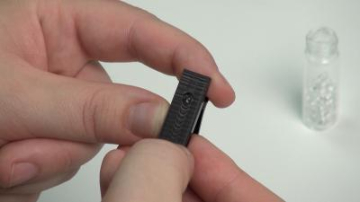
How to 3D print a high-powered smartphone microscope for a dollar
Mike McLeod
Additive Manufacturing Medical 3D printing Additive Manufacturing slideshowDOE researchers offer STL files, glass beads for a 1000x microscope that clips to an smartphone or tablet.

This small 3-D-printed microscope — developed by the U.S. Department of Energy’s Pacific Northwest National Laboratory — clips to a common smartphone and can magnify up to 1000x. (Photo credit: PNNL)
The clip-on instruments use small glass beads—which cost about a penny a piece—as a lens, and can provide magnification of 100x, 350x and 1000x depending on the bead size. Designed to fit snugly on an iPhone, iPad and other smartphones, the plastic clips can be quickly output on a 3D printer using PNNL’s STL design files the lab provides free from its web site. The lab also provides links to web sites that sell the glass beads. In total, the PNNL scientists say microscope’s material cost, not including the printer, is under $1.
“We believe it can fill a need for professional first responders, and also for teachers and students in the classroom, health workers and anyone who just wants an inexpensive microscope readily available,” says Rebecca Erikson, a PNNL applied physicist.
According to the PNNL team, the glass beads provide enough clear magnification to identify tiny pathogens, parasites in blood samples or drinking water or give students a close-up view of things like salt grains, bugs and flower petals.
“We feel there are many uses out there including human and veterinary medicine in developing countries,” said Janine Hutchison a microbiologist at PNNL. “We are also excited about engaging kids in science. School districts have a hard time providing enough microscopes for students. Our science education staff is actively engaged in getting it into the hands of local school children this fall.”
http://availabletechnologies.pnnl.gov
